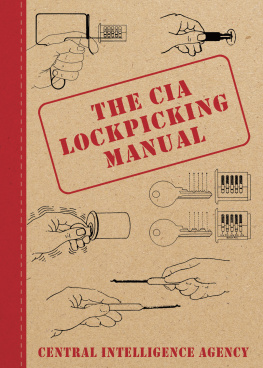Locks
& Lock Picking
for Beginners
M.G. EVANS
Copyright 2017, M.G. Evans
All Rights Reserved
All rights reserved. No part of this publication may be reproduced, distributed, or transmitted in any form or by any means, including photocopying, recording, or other electronic or mechanical methods, without the prior written permission of the publisher, except in the case of brief quotations embodied in critical reviews and certain other non-commercial uses permitted by copyright law.
Printed in the United Kingdom
First Edition
Introduction
Welcome to the beginners guide to becoming a Locksmith. You may have found your way here for a variety of different reasons, but at last, you are here!
Regardless of your motivations for picking this book, I am sure you will find something that will help. People become interested in learning the art of locksmithing for many different reasons. For some, it is to start a new career. For others, it is a new hobby. For some, it is because they are interested in learning what many believe is a secret art.
First, let me clear something up. Locksmithing is not a secret art, and it is certainly not difficult. If you have an ability to learn and a lot of patience, you will find this an interesting and in many ways a rewarding skill.
Before we go any further, I think it is important for you to understand the background, where it all started, and how we have found ourselves here today.
A Brief History of the Lock
Since the birth of civilisation, man has wanted to keep his most treasured possessions safe. Students of the art believe the first lock was made from wood in ancient Egypt. This first lock would have used a simple tumbler system. Moving forward through time, the Greeks developed designs that are more advanced, and the Romans later perfected these. The Romans used modern materials such as tempered metals; this gave the locks much more strength over their Greek cousins.
The greatest advancement in lock design came around the 20 th century when Harry Soref produced the first padlock in 1924. Since that time, modern manufacturing processes have allowed the lock to develop into a much more complicated device, stronger than ever and more difficult to manipulate. They also have improved the security features used to hinder the lock pickers. Modern features include magnetic locks and keys, multiple pin locks, and electronic devices.
The Present Day
Ok, now we all have a little more understanding about where it all began, let us advance to the present day. The modern lock is nothing more than a barrier. Many things in the world have these. Their sole purpose is to restrict those who we want to discourage and admit only those whom we choose, to one degree or another. A barrier according to the English dictionary is anything that restricts or obstructs access.
That put simply into laymans terms means here is a door, lock, and a key. Most external doors will have one, sometimes more, dependent upon the premises.
Sometimes we have internal door locks. If you consider for a moment a building to which the public may be admitted may have open areas and spaces to where they are not permitted. In an office block, some employees may have access to some rooms, but not others. A hotel is a building where there are many private areas. All of these have one thing in common: they all have doors with locks on them to restrict access.
You may be thinking by this point that this all seems a little obvious. To some that may be true, but it certainly helps us to be relaxed when trying to open a locked door. This can be achieved by having a full understanding of the challenge before you. They say that knowledge is power. In this case, I have certainly found that to be true.
When it comes to locks, if you do not understand how it works, you havent got a chance of being able to get past it.
As you go about your daily life, take a moment to look at front doors as you pass by them. Consider the composition of the door. Is the door made of uPVC or is it wooden? It may not seem important at this stage, but it will when attempting to open it without a key. Consider your own home for a moment, what type of front door do you have? If it is a uPVC door, how does the door operate? Do you simply close the door, and it locks automatically behind you? Must you lift the handle and hear things dropping into place? We will learn more of these things a little later.
There are many types of locks in use today; the most common ones being the Rim Cylinder, the Euro lock, the 3-lever or 5-lever mortise lock, and the wafer lock.
We will look at all of these. In turn, we will uncover their construction and design, we will look at their strengths and weaknesses, how to manipulate the lock into opening (in the trade this is called bypassing) by non-destructive and destructive means and how to replace them.
The Types of Locks
The Rim Cylinder
Often referred to as Yale lock and fitted to either older properties or sometimes a new build, but in the main, they are used on wooden doors. These locks allow you to enter or leave a building and close the door with the lock automatically securing the door.
The Rim Cylinder operates on a simple pin system. Look at the key below. Along its underside, you can see that the edge appears serrated. This part does the work of opening and closing the lock. Along the top of the key, you can see a groove and a shoulder. All of these play a part when you push the key into the lock and turn it.
The shoulder ensures that the key is placed into the lock in exactly the right place. Were it not for the shoulder, the key would not work. Its function is to line up the serrated edge with the pins inside the lock.
The grooves ensure that the correct key is placed into the lock. Different lock manufacturers use a slightly different profile, meaning that the grooves are milled into the key at different heights. If you look at the front of the lock, you can see where the grooves will fit.
The serrated edge, the teeth are all varying depths, this is the main part of the lock. Inside the Rim Cylinder lock, small spring loaded pins keep the lock open or close the internal movement of the lock. These pins are designed to work with this specific key. As the key is inserted into the lock, the corresponding pins match up with the teeth along the edge of the key and push the spring-loaded pins into a specific position. This position will determine whether the lock will turn and open the lock. See the image below and you will notice the springs underneath the pins that push upwards. The pins are actually split along a seam. With the key inserted the pins pushing against the key the seam will line up along the barrel of the lock and the lock will be able to turn. It only takes one of these pins to not be lined up properly and the lock will remain secure.
Although a relatively basic design, one that has been around in one form or another for a very long time, the main strength of this system is its simplicity and its durability. Consider how many times throughout its life a door lock is turned, always open to the elements, subjected every day to turning forces, and it responds diligently. Always doing what it was intended to do. Over the years, many enhancements have improved the security of this simple lock, but in design, it is almost the same as it has always been.
The strength of this lock is also its biggest weakness. The fact that it operates so simply means that it can be bypassed almost as simply as it can be opened with a key. Dependent upon the method employed means that within a second or two most of these locks can be bypassed by non-destructive methods. We will learn more about these a little later.





